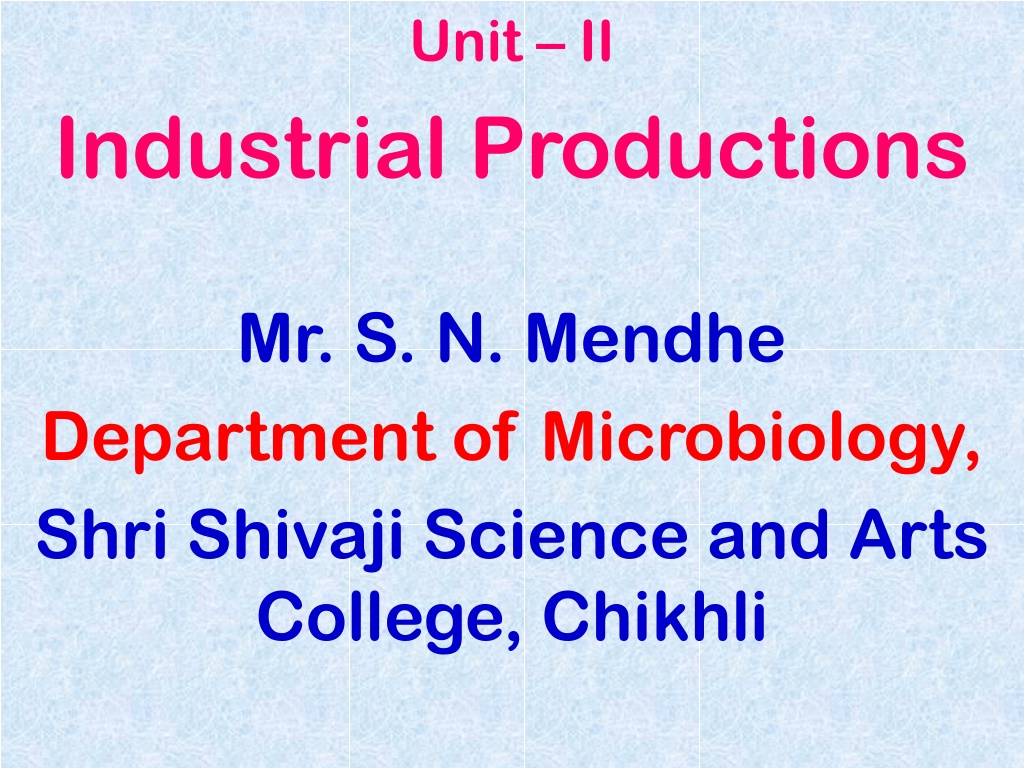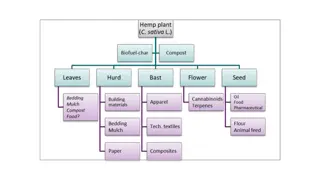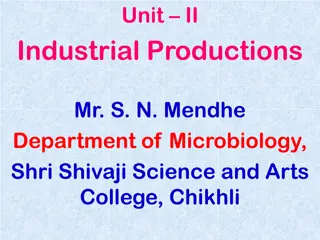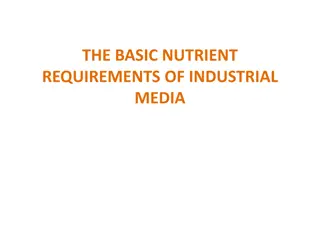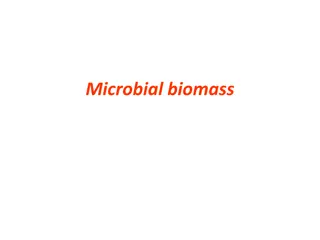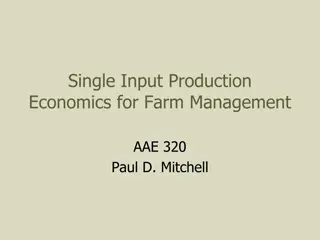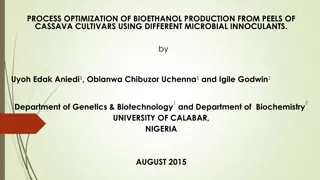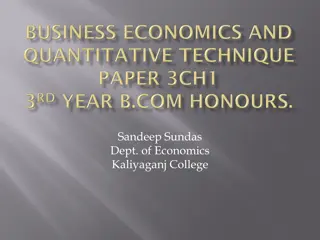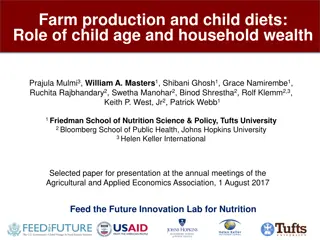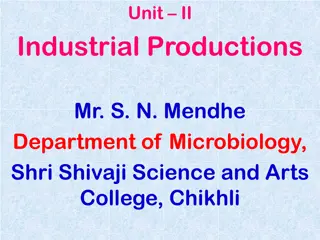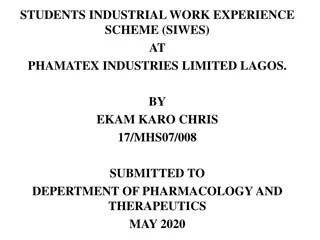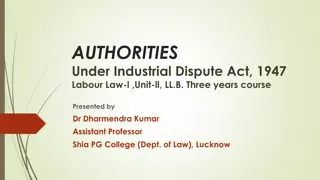Industrial Production of Wines: Process and Classes
Wine production involves fermentation of grapes with variations in color, alcohol, and sugar content, resulting in different classes of wines like red, white, sweet, dry, sparkling. The process includes grape selection, fermentation, aging, and bottling to create high-quality wines.
Download Presentation

Please find below an Image/Link to download the presentation.
The content on the website is provided AS IS for your information and personal use only. It may not be sold, licensed, or shared on other websites without obtaining consent from the author. Download presentation by click this link. If you encounter any issues during the download, it is possible that the publisher has removed the file from their server.
E N D
Presentation Transcript
Unit II Industrial Productions Mr. S. N. Mendhe Department of Microbiology, Shri Shivaji Science and Arts College, Chikhli
INDUSTRIAL PRODUCTION OF WINES INDUSTRIAL PRODUCTION OF WINES Wine is the product fermentation of the fresh, sound and ripe grapes. It is an example of alcoholic beverage. Beverages produced from alcoholic fermentation of other fruits are also called as wines, e.g., pear wine (from pears), orange wine (from orange), cherry wine (from cherry), blackberry wine (from berry), cidar wine (from apples) etc. CLASSES OF WINES:- There are endless varieties of wines and vary in color, alcohol content, sugar content etc. and it is difficult to classify them. Some important classes of wines are Table wine-It contains about 8 15 % alcohol by volume and is either red table wine when it is red in color or made by normal alcoholic
white table wine when it is white in color. Red wines- Are red in color due to extraction of color components from the skin of grapes. In making red wines, grapes are crushed and fermented along with the skin, stems and pits, and are only subsequently pressed. White wines Are colorless and are made from white grapes or from the juice of grapes from which the skin have been removed. Sweet wines- These wines contain high sugar concentration, which can be detected by taste. Dry wines These wines contains too little sugar concentration to be detected by taste. Sparkling wines These wines contain CO2and are made effervescent by secondary fermentation in closed containers generally in bottle itself.
Still wines These wines do not contain CO2. Fortified wines These wines contains added alcohol in the form of brandy. COMPOSITION OF WINES:- Finished wines vary widely in their composition. Average composition of wines may be as follows. Extract ----- 2.3 % Carbohydrates ----- 0.03 0.5 % Acids ----- 0.5 1.0 % Ash ----- 0.13 0.15 % Tannins ------Traces Amino acids ------Traces Aroma substances --- Traces Alcohol ----- 8 13 %
WINE MAKING PROCESS:- The wine making process can be divided into following steps. Grapes Microorganism Fermentation process Racking Storage and aging Further Clarification and Bottling 1. Grapes:- Production of fine quality of wines depends on quality of grapes. Grapes should be gathered at proper stage of their maturity means the content of fermentable sugars
sugars i.e. glucose and fructose are at optimum level. While collecting the grapes and transporting them to the wine industry they should be collected in clean container and should be protected from deterioration. The grapes are first separated from stems and then crushed in machines. The metal used in the fabrication of machine has a profound effect on quality of wines, and hence machines composed of stainless steel or nickel is generally used in preference to iron, ordinary steel and bronze. The crushed grape juice is called as Must .
The production if white wines differ from that of red wines. In white wines it is not essential to extract the coloring matter and tannins present in the grapes skin, while in the production of red wines it is very important to extract the coloring matter and tannin. The latter stages of fermentation for the production of both white and red wines are similar. In the production of red wines the color can be extracted by the alcohol, which forms during fermentation. Grapes contain a large number of microorganisms on their surface. This microbial flora cause undesirable changes in crushed grapes. Therefore, crushed grapes immediately treated with SO2or sulphites, which inhibits the growth of many
undesirable types of microorganisms. Usually 2 to 6 oz of potassium metabisulphites added per ton of crushed grapes. 2. Microorganism:- A large number of yeasts are involved in the production of wines. Saccharomyces cerevisiae variety ellipsoidus is the best yeast for wine production. A starter is prepared from the pure culture of yeast. The amount of inoculum used should be 2 to 5 % of the volume of crushed grapes. 3. Fermentation process:- The fermentation is carried out in open or closed vessels. Fermentation vessel is filled with Must and inoculated with starter culture.
Yeast culture is added 6 hrs after the treatment with SO2. Following fermentation conditions are maintained in order to obtain fine quality of wines. a) Nutrient addition:- it is usually unnecessary to add any nutrients in grape juice for yeast nutrition because it contains most of the nutrients. But sometimes ammonium sulphate or phosphate is added. b)Concentration of sugar:- Optimum concentration of sugar should be adjusted. Higher sugar concentration favors the production of more than 13 % alcohol by volume and high alcohol content tends to inhibit fermentation activity of yeast. Maximum 13 % sugar concentration is desirable.
c)Temperature:- The fermentation process is carried out with the temperature range of 15 to 350C. Temperature above 200C affects the quality of white wines and hence temperature should not exceed 200C. However, for the production of red wines the temperature of fermentation is kept between 20 to 300C. Temperature above fermentation process. 350C diminishes
d) pH :- The pH of the grape juice varies between 3.0 to 3.9 because of its acid content, mainly tartaric acid, malic acid and citric acid. This low pH is considered to be favorable for yeast activity. The grapes that have permitted to become too mature or over ripe possess low acid content and high sugar content. Then in that case fruit acid tartaric acid, malic acid or citric acid may be added to restore the normal acidity. e) Oxygen supply:- Large supply of oxygen is essential in the beginning of fermentation for the rapid multiplication of yeast cells. While later stage characterized by alcohol and CO2 production rather than growth progress under anaerobic condition.
f) Pressing:- After 3 to 5 days of active fermentation sufficient tannins and color is extracted from the skin of grapes. When the color and tannin content is satisfactory the wine makers draw off the wine to separate it from the pomace (skin, seeds and pieces of stem). He does not wait for all sugar to be fermented. Pomace is separated from wine by pressing. g) Further fermentation:- Wine free from pomace is placed in closed storage tanks. An atmosphere of CO2gas over the wine tends to inhibit the development of undesirable bacteria. Residual sugars are fermented within 7 to 10 days.
4. Racking:- Potassium bitartarate, tannins, proteins, yeast sediments at the end of fermentation. Wines are racked to separate the wines from sediment. Racking is performed to facilitate clearing of wines and prevents undesirable flavors from being extracted from the old yeast cells. 5. Storage and Aging:- The most important changes that take place during storage and aging are clearing of wine and development of flavor. Wine is placed in tanks for aging. Wine storage tanks are generally constructed of white oak or red wood. The tanks are completely filled with wine and sealed to prevent the entry of oxygen, which favors the growth of acetic acid bacteria and cause spoilage of wine.
Wines should be aged at least 8 to 10 months before consumption. Wine is harsh and fermentation, but it gradually develops color, aroma and flavor during storage. 6. Further Clarification and Bottling:- In most of the modern wine making industries, further clarification of wines is done with finings such as casein, gelatin, bentonite, spanish clay etc. The clarified wine is placed in oak barrels for bulk sale and in bottles or cans for unit sale. undrinkable after
Defects of Wines Defects of Wines: :- - These are caused by microorganisms and are known as diseases of wine . Generally wine diseases are of two types. 1) Diseases caused by aerobic microorganisms The aerobic diseases are caused by mycodermas and acetic acid bacteria. These microorganisms grow well in wines in the presence of oxygen. Mycoderma forms a film over the surface of wine and attack alcohol and occasionally organic acids present in wine. On the other hand acetic acid bacteria produce vinegar (acetic acid) from wine in the presence of oxygen unless they are destroyed or prevented from growing. CH3CH2OH + O2 Ethanol 2) Diseases caused by Facultative Anaerobes or Anaerobes CH3COOH Acetic acid
